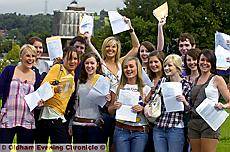Record students reap rewards
Date published: 15 August 2008

Photo: VINCENT BROWN
TOP of the class... North Chadderton pupils celebrate
A-level stories of the day
PRAISE has continued to pour in for Oldham’s awesome A-level students.
For the first time the national pass rate smashed 97 per cent and 25.9 per cent of passes were A grades — up from 25.3 per cent in 2007.
Oldham Sixth Form College and Our Lady’s are celebrating record results. And as reported in the Chronicle yesterday, pass rates have also risen at North Chadderton.
At Hulme Grammar School the pass rate was 99 per cent with 13 out of 80 students chalking up at least three or more A grades.
Katy Laverty will read history at Manchester University after receiving an amazing 5 A grades.
Emma Howarth achieved 4 A grades (plus 2 As at AS level) and will study medicine at Birmingham University.
Emma received one of the top 10 marks in the country for human biology while Charlotte Watson was placed in the top five for English literature with a perfect score.
Principal Dr Paul Neeson said: “It is always pleasing to see students achieve their potential and open the doors to future success. In total, 83 per cent of grades achieved were A, B and C, which will ensure that our students earn places at the best universities in the country and on the most competitive courses.”
Oldham’s two Church of England high schools are celebrating similar results to last year.
At Blue Coat, around 50 per cent of passes were at A and B and the average point score is up by 3 per cent.
Deputy head teacher Brian Devenport said: “It’s gone very well. We are going to have a lot of happy people.
“They really have turned it on in the upper sixth and I am personally very pleased for them.”
Crompton House had a 96.3 per cent pass rate. Deputy head teacher Charles Whitehead added: “The school is extremely proud of its young people, their parents and their teachers.
“The outstanding results reflect years of dedication and sheer hard work. We congratulate all our students and wish them well in the future.”
The national pass rate rose for the 26th year in a row to 97.2 per cent with 827,737 A-level entries, up 2.7 per cent.
There was an increase of 7.5 per cent in the number of pupils taking maths (64,593 in total), the highest for a decade. But English was the most popular A-level with 89,111 (10.8 per cent) of candidates taking it.
Ed Balls, Secretary of State for Children, Schools and Families, said: “I sincerely hope that this year, with the formation of the new independent standards regulator Ofqual, we can finally begin to put a stop to the annual sterile debate which claims that improved results mean dumbing down.”
A new A* grade will be introduced in 2010 while from this September students will be able to study for new diplomas worth up to three-and-a-half A-levels.
Oldham College will work with several schools to initially offer diplomas in two subjects: construction and the built environment and creative and media.
Gap between rich and poor remains
THE Tories have condemned the gap between the rich and poor with figures showing only four in 10 students who took GCSEs in Oldham also sat A-level exams.
The Conservatives have called for parents to be given more control over schools in a bid to end the so-called post code lottery across the country.
The figures show in 2004/05 3,185 pupils were entered for GCSEs across the district but only 1,305 took A-levels two years later — 40.9 per cent.
Nationally, 44 per cent of students took both sets of exams in the time period, but across the country there are serious discrepancies.
In Rochdale, Knowsley and Sandwell, the figure is one in eight or fewer pupils, compared with a 100 per cent rate in more affluent Westminster, Kensington and Chelsea and Richmond-upon-Thames.
Shadow Schools Minister Nick Gibb said: “People will be shocked to see that there are areas of the country where fewer than one in eight children sit A-levels. As ever it is the poorest areas that are worst affected.
“It is a scandal that in some of the most deprived parts of the country there are more children under-18 not in education, employment or training than there are studying for top academic qualifications.”
Most Viewed News Stories
- 1Pair sentenced for firearms offences in Oldham
- 2Council chopped down trees 10 months ago, but the cuttings still remain
- 3Royton friends set to take on 90-mile charity walk in memory of popular local dad
- 4Dynamic rescue team duo pledge to raise funds for brave Finn
- 5CWTC event proves a major success




